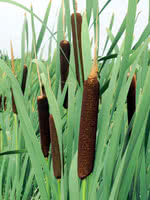Mon-Fri 9am - 5pm Mountain time
Common Cattail vs Black Elderberry
Sambucus canadensis
Typha latifolia
NOT AVAILABLE THIS SEASON - MIGHT RETURN
CUSTOM GROW
Black Elderberry is a deciduous shrub native to eastern North America. You can plant this shrub in moist areas and it will help stabilize your soil. You can also use it on rural properties anywhere you'd use a lilac.
Black Elderberries are considered to be partially self-pollinating. So while they will still produce some berries without cross-pollination, planting with another variety will increase yields. Consider planting with Ranch Elderberry or Bob Gordon Elderberry.
Warning: the seeds, stems, leaves, roots, and uncooked berries of the Black Elderberry are poisonous to humans when eaten in quantity. You should cook the berries to make them safe for human consumption.
Cattail is found all across North America, growing next to water. Like other waterside plants, Cattail provides erosion control and forage for animals.
It is suitable for land reclamation. Cattail is able to tolerate cold weather and occasional flooding.
Black Elderberry Quick Facts
Common Cattail Quick Facts
Toxicity: leaves, stems, and uncooked berries are poisonous to humans

